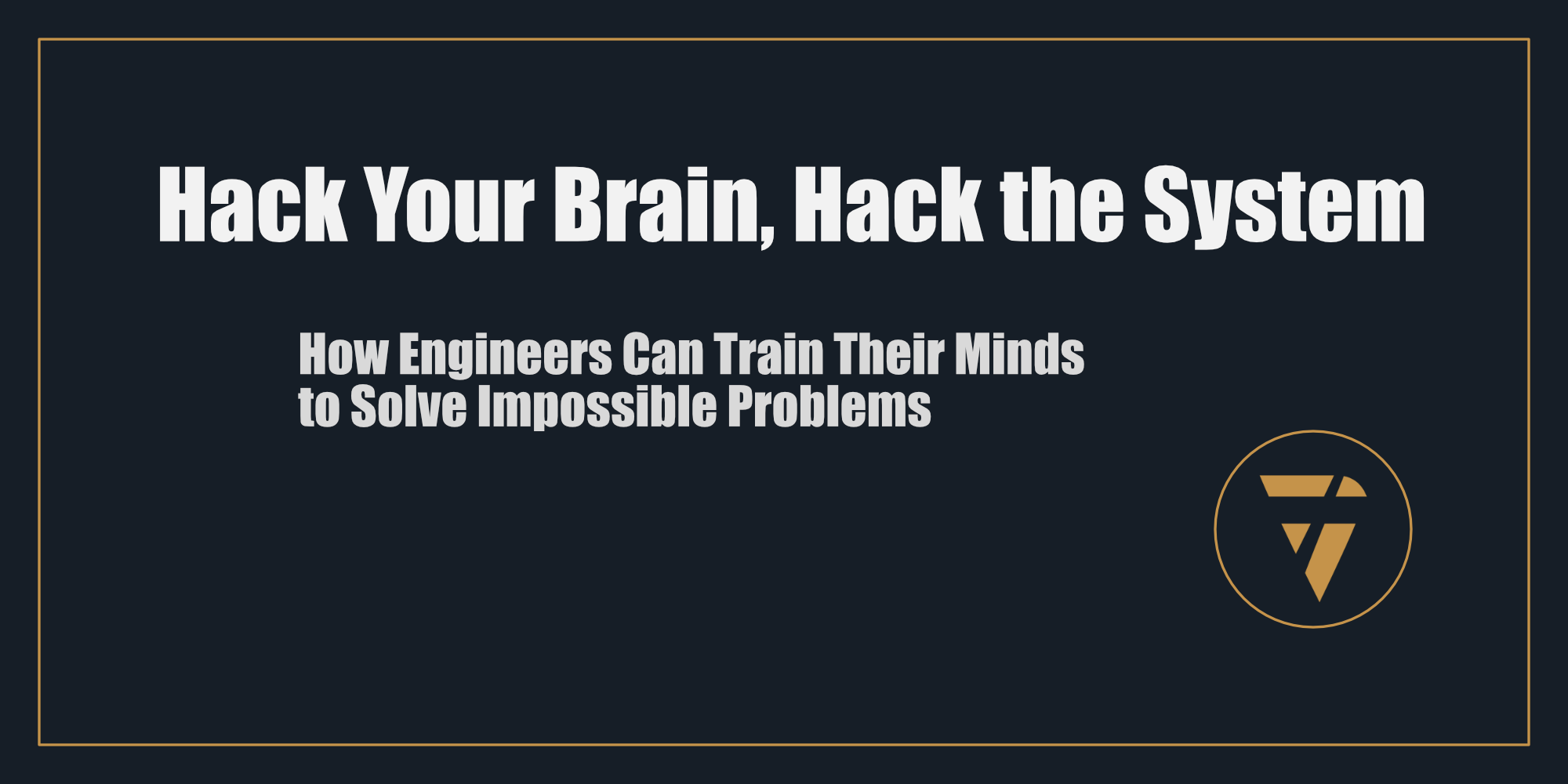Hack Your Brain, Hack the System
How Engineers Can Train Their Minds to Solve Impossible Problems

Engineering isn’t just about coding, circuits, or structural integrity—it’s a mental game. The best engineers aren’t just technical wizards; they’re creative problem solvers who think around corners, under pressure, and against odds that would make most people fold.
But what if the secret to solving impossible problems isn’t in the hardware or software, but in the wetware—your brain? With the right mental hacks, inspired by strategic mindfulness, neuroplasticity, and tactical awareness, you can train your mind to reframe challenges, spot opportunities, and deliver solutions no one else sees.
Here’s how to hack your brain—and in doing so, hack the system.
The First Mind Hack: Reframe the Problem
When Apollo 13’s oxygen tank exploded, the team at NASA didn’t panic (okay, maybe a little). They reframed the problem from “How do we fix the spacecraft?” to “How do we keep the astronauts alive with what we’ve got?” This shift in perspective led to one of the most ingenious engineering solutions in history.
How to Apply It:
- Take a deep breath and ask, What’s the real goal here? Often, the way a problem is framed limits the possible solutions.
- Reframe the problem by focusing on outcomes rather than obstacles. Instead of “How do I fix this bug?” try “How do I deliver the user experience this fix enables?”
Mindfulness Technique:
Spend 5 minutes each morning practicing “Zoom Out” mindfulness. Visualize yourself stepping back from a problem and seeing it in the context of the bigger picture. What does the problem enable? What assumptions are you making that could be challenged?
The Second Mind Hack: Embrace Strategic Stupidity
Great breakthroughs often start with dumb questions. Why? Because “dumb” questions challenge assumptions and make the obvious visible. The Wright brothers didn’t ask, “How do birds fly?” They asked, “Why can’t we?”
How to Apply It:
- Hold a “Stupid Question Session” with your team. No question is too basic or outlandish. The answers often reveal blind spots or fresh angles.
- Ask yourself: “If I didn’t know anything about this problem, what would I try first?”
Neuroplasticity Boost:
Jot down three “impossible” questions related to your work every day. Over time, you’ll train your brain to seek unconventional answers.
The Third Mind Hack: Use the Power of Micro-Focus
Our brains are masters at distraction, flitting between tasks like a hyperactive squirrel. But great engineers know how to enter deep work states, where focus is absolute and breakthroughs happen.
How to Apply It:
- Use the Pomodoro Technique to work in 25-minute sprints, with 5-minute breaks. During those 25 minutes, nothing else exists—no emails, no Slack, no bathroom breaks.
- Before starting, visualize the task as a puzzle you’re determined to solve.
Mindfulness Technique:
Before each work session, spend 60 seconds focusing on your breath. This anchors your mind, reducing cognitive clutter and priming you for laser-sharp concentration.
The Fourth Mind Hack: Hack the Environment
Your workspace is a reflection of your mental state. A cluttered desk often leads to a cluttered mind, while a well-designed environment can amplify creativity and focus.
How to Apply It:
- Rearrange your workspace to reflect the kind of thinking you want to encourage. Need creativity? Add objects that inspire curiosity. Need focus? Keep it minimalist.
- Change your location to shake up your perspective. Some of the best ideas happen on walks or in coffee shops.
Neuroplasticity Boost:
Expose your brain to new stimuli daily. Try reading a book outside your field, taking a new route to work, or listening to unfamiliar music. Novelty rewires the brain, enhancing problem-solving skills.
The Fifth Mind Hack: Leverage Tactical Awareness
In Special Forces training, soldiers are taught to maintain “tactical awareness”—a state of calm focus where they perceive threats and opportunities others miss. Engineers can apply the same principle to see the “hidden variables” in problems.
How to Apply It:
- Start each day by identifying key opportunities and risks in your current projects.
- When stuck, ask: “What am I missing? What variables haven’t I accounted for?”
Mindfulness Technique:
Practice a daily body scan meditation to cultivate awareness. This trains you to notice subtle cues—whether they’re in your body, your code, or your environment.

The Mindset Shift: From Problem-Solver to Possibility-Maker
The best engineers don’t just solve problems—they create possibilities. They hack their own mental systems to find opportunities where others see dead ends.
By integrating strategic mindfulness, neuroplasticity practices, and tactical awareness into your daily routine, you can train your brain to work smarter, adapt faster, and thrive under pressure.
Your Brain-Hacking Challenge
This week, try one of these mind hacks:
- Spend 5 minutes reframing a persistent problem in your life or work.
- Ask a “stupid” question about a project and explore its implications.
- Dedicate one Pomodoro sprint to tackling a tough challenge with zero distractions.
Share your experience, or connect with me to discuss how hacking your brain can help you hack the system.
Impossible problems? They’re just puzzles waiting for a better perspective. Let’s solve them together.
This Substack is reader-supported. To receive new posts and support my work, consider becoming a free or paid subscriber.
This is what I’m working on. Tell me what you think, I enjoy the conversation! Subscribe and follow the work in real time.
Thanks!
B
Impossible problems aren’t impossible—they’re just puzzles your brain hasn’t hacked yet. Reframe, focus, ask the ‘dumb’ questions, and watch solutions appear. Hack your mind, hack the system.
PS -





